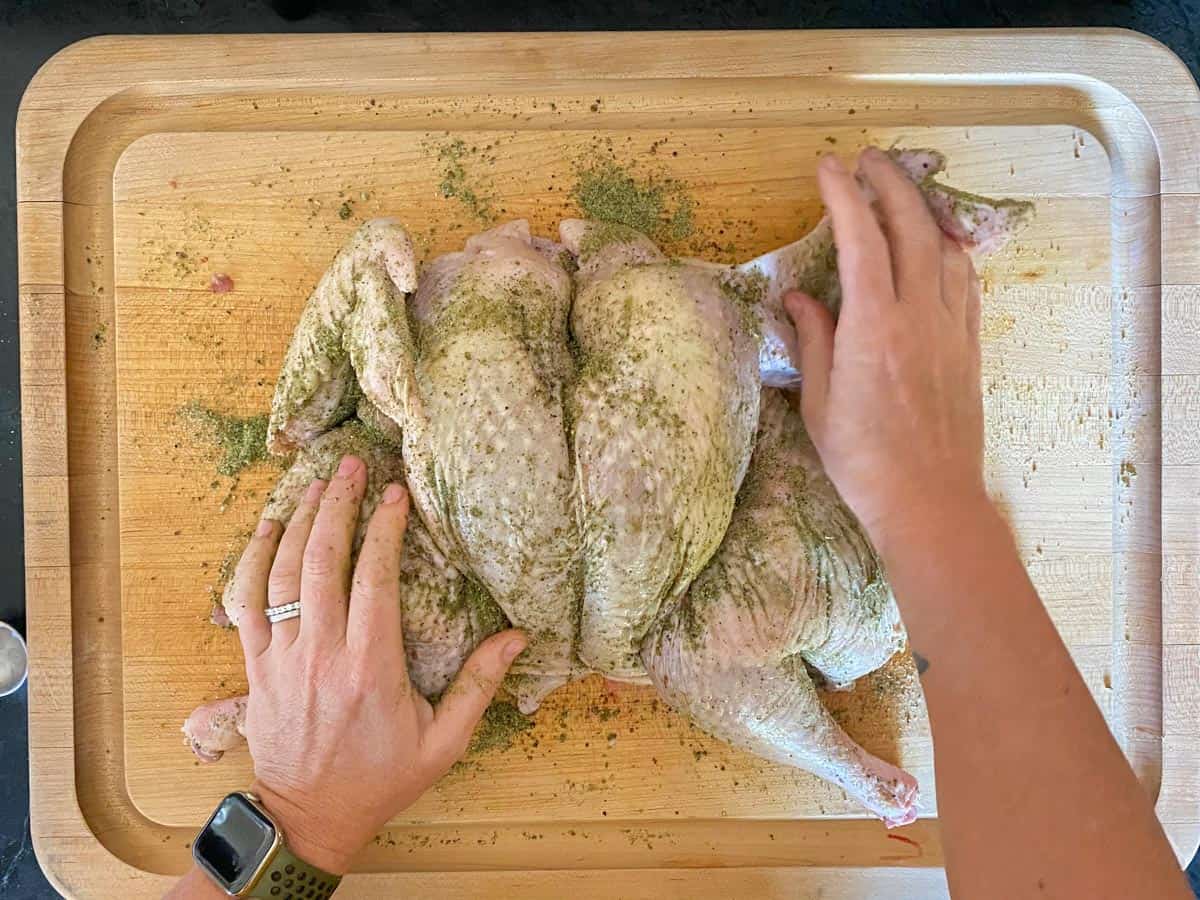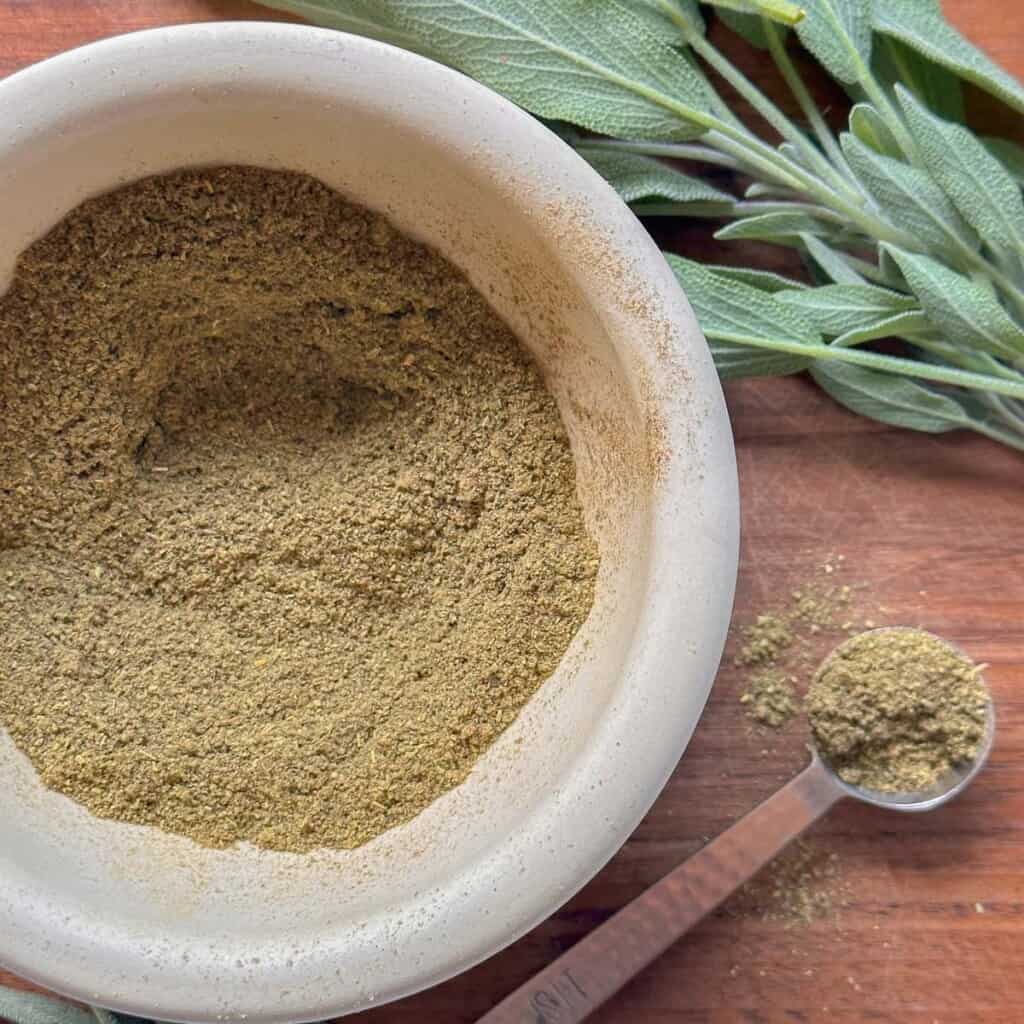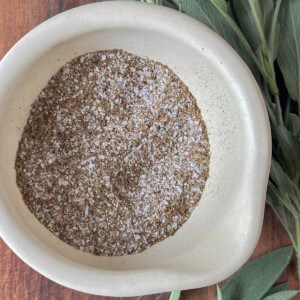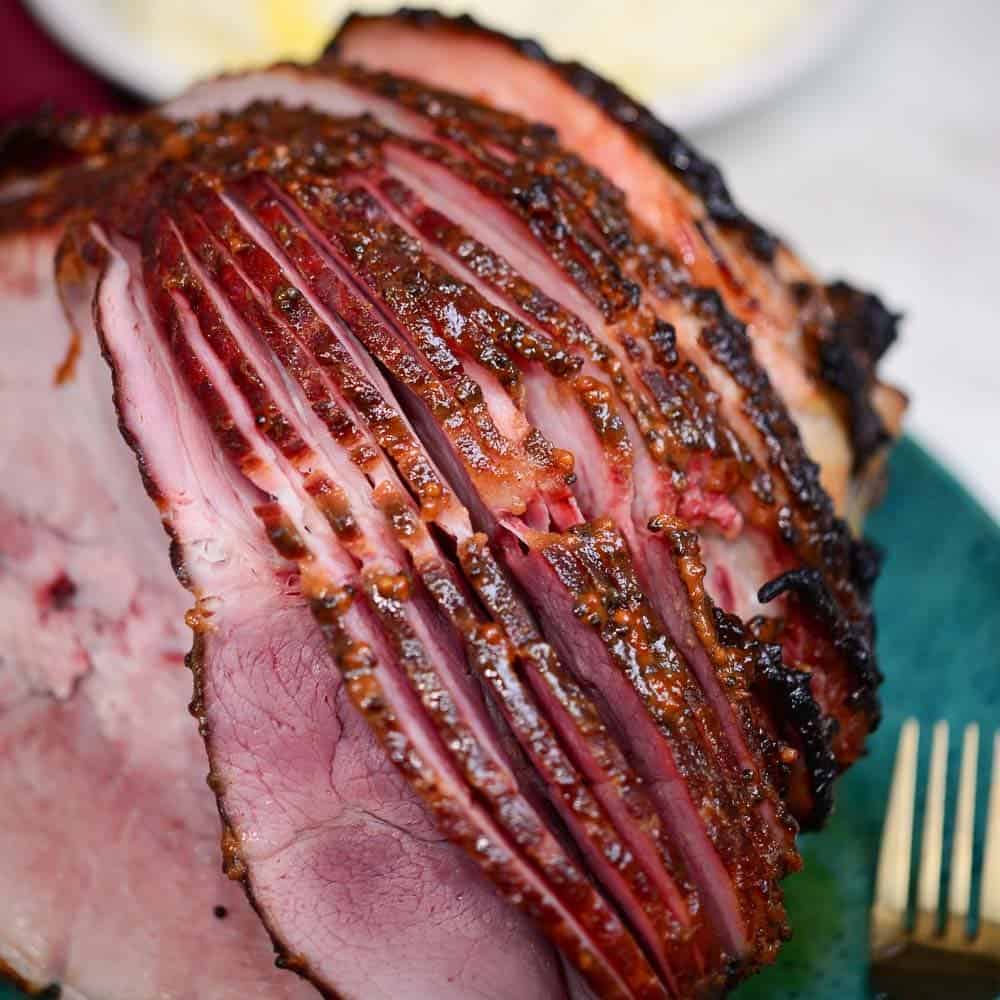Savory Delight: The Ultimate Dry Rub for Juicy Turkey
When it comes to preparing a mouthwatering turkey that leaves your guests begging for seconds, the secret lies in the seasoning. This tried-and-true dry rub recipe will elevate your turkey to a whole new level of deliciousness.
Whether it’s Thanksgiving, a holiday feast, or a special family dinner, this turkey seasoning recipe will make your turkey a star.
Dry Rub For Turkey will add flavor to your Thanksgiving Turkey. See how to use this poultry rub to season my Spatchcock Turkey. You won’t find a more flavorful turkey recipe.

If you want to keep things on a smaller scale and not cook a whole bird, you can also use this dry rub recipe to make Smoked Turkey Breasts or Smoked Turkey Legs.
For more info about adding flavor to turkey, check out my Ultimate Geek Guide to How To Brine Meat.
Why You’ll Love This Homemade Turkey Rub Recipe
- The combination of spices adds layers of flavor, making your turkey savory, aromatic, and mouthwateringly good.
- Dry brining not only adds flavor but creates a deliciously crispy skin.
- All the ingredients in this dry rub are easily accessible, making it a convenient choice for any home cook.
- This recipe is incredibly versatile and can be adapted to suit your personal taste preferences.
Ingredients For Dry Rub For Turkey
You can make the BEST homemade turkey rub recipe with just a few simple spices. This blend of savory spices adds lots of flavor to roast turkey and grilled turkey.

- Salt: Salt is essential for dry brining. Make sure to use Kosher salt or sea salt. I always steer clear of table salt.
- Dried thyme: Dried thyme has a warm and earthy flavor with subtle floral and minty notes. It is aromatic and slightly woodsy. Thyme adds depth and complexity to savory dishes, including soups, stews, roasted meats, and poultry.
- Rubbed sage: Sage has a strong, earthy flavor with a hint of mint and a slightly peppery undertone. It releases its aromatic oils when rubbed or crushed, intensifying its flavor. Sage is commonly used in stuffing, poultry seasoning, and dishes with rich, hearty flavors, such as roasted meats and sausages.
- Allspice berries: Allspice berries have a flavor profile that combines the tastes of cinnamon, nutmeg, and cloves. It is warm, sweet, and slightly spicy, with a hint of peppery notes. Allspice is a key ingredient in many spice blends and can be used in sweet and savory dishes.
- Juniper berries: Juniper berries have a piney and resinous flavor with a touch of citrus and earthiness. They are commonly associated with gin but are also used to flavor game meats. Juniper berries add a unique, aromatic complexity to dishes.
- Pink peppercorn: Pink peppercorns have a mild, fruity, and slightly sweet flavor with a subtle peppery heat. They are less pungent than black peppercorns and are often used for their decorative appeal as well as flavor.
- Black peppercorn: Black peppercorns have a sharp, pungent, and spicy flavor with hints of citrus and earthiness.
This turkey seasoning rub recipe differs from poultry seasoning because it contains a blend of salt and spices. Poultry seasoning is usually a finely pulverized powder that contains no salt.
Turkey Rub Variations
I give you a full creative license to experiment with your dry rub recipe. This version of dry rub is a perfect blend of spices that I love to use as a smoked turkey rub when I am grilling or smoking a turkey. It’s very similar to my BBQ rub recipe.
- Salt: Salt is essential for enhancing the turkey’s natural flavors and keeping it moist. Kosher salt is perfect for this job.
- Paprika: Paprika adds a rich, smoky flavor and a gorgeous color to your turkey. It’s the foundation of this dry rub.
- Black Pepper: Freshly ground black pepper adds a subtle kick and balances the flavors in the rub.
- Garlic Powder: Garlic powder infuses a delightful aromatic quality and savory depth.
- Onion Powder: Onion powder complements the garlic powder, providing a mild and sweet flavor.
- Dried Thyme: Thyme adds a hint of earthiness and herbal freshness to your turkey.
- Brown Sugar: Brown sugar brings a sweetness that caramelizes beautifully during cooking, creating a mouthwatering crust.
- Cayenne Pepper (Optional): For those who enjoy a bit of heat, a pinch of cayenne pepper can be added for a gentle kick.
Try other spices in your homemade spice rub: dry mustard, red pepper flakes, dried or fresh orange zest, rosemary, and chili powder.
How To Make Dry Rub
Start by gathering your spices. I order spices from an online source like Mountain Rose Herbs or Penzy’s. Whole Foods also has a relatively decent collection of bulk spices.
When working with whole spices, use a spice grinder to pulverize your spices into a fine powder. If you are using ground spices, you have to mix the dried spices in a small bowl.

- Set any salt or sugar aside.
- Combine the dried whole spices in the spice grinder and pulse until they are finely ground.
- Mix the pulverized spices with the kosher salt. in a small bowl and stir to combine.
- Store in an airtight container until you are ready to use.
What is Dry Brining?—The Nerdy Details
Dry brining is a culinary secret that can transform your meat into a succulent, flavorful masterpiece. It’s the easiest way to add flavor to your next turkey dinner.
Unlike wet brine, which involves soaking meat in a liquid solution, dry brining relies on the power of salt and time to work its magic. In this guide, we’ll explore the science behind dry brining and how you can use it to elevate your dishes to new heights.

The Essence of Dry Brining:
Understanding Dry Brining:
Dry brining is a process that involves coating your meat with a mixture of salt and sometimes other seasonings, like herbs and spices. This mixture is applied directly to the meat’s surface, drawing out moisture and reabsorbing it, resulting in seasoned and incredibly juicy meat.
Osmosis in Action:
Like wet brining, dry brining A dry bine infuses flavor into the meat by osmosis. While this sounds like magic…it’s more science than magic. Salt applied to the meat’s surface initially draws out moisture. However, unlike wet brining, no excess liquid dilutes the flavors, so the salt and seasonings remain concentrated, enhancing the meat’s taste.
Simplicity and Convenience:
One of the advantages of dry brining is its simplicity. You don’t need a large container or excess liquid. Plus, there’s no need to rinse the meat after the brining process, making it a convenient option for home cooks.
Advantages of Dry Brining:
- Enhanced Flavor: Dry brining imparts a deeper and more concentrated flavor compared to traditional seasoning methods.
- Juiciness: By drawing out and reabsorbing moisture, dry brining ensures your meat remains tender and juicy throughout cooking.
- Simplicity: Dry brining is straightforward and doesn’t require special equipment or extra space in your fridge.
- Customization: You have the freedom to experiment with different herbs and spices in your dry brine to create unique flavor profiles. There are so many different ways to make homemade rubs.

In conclusion, dry brining is a culinary technique that marries simplicity with extraordinary flavor. By understanding how dry brining works and following the steps outlined in this guide, you can take your cooking to new heights and delight your taste buds with every bite. So, give it a try and let the magic of dry brining elevate your next meal.
How To Dry Brine Turkey
- Prep Your Turkey: Make sure your turkey is clean before applying the rub. I recommend a quick rinse with cool water and then pat it dry (inside and out) with paper towels.
- Rub It In: Mix all the dry rub ingredients in a bowl. Generously apply the spice blend all over the outside of the turkey, including under the skin of the turkey and inside the cavity.
- Let It Rest: Allow the turkey to rest with the rub for at least an hour or, ideally, overnight and up to 4 days before cooking. This allows the flavors to penetrate deeply.
- Cook to Perfection: Roast your turkey according to your preferred method. The dry rub will work its magic, creating a crispy, flavorful crust and juicy, tender meat.

How To Cook A Dry Brined Turkey
When the big day is here, and you’re ready to cook the perfect holiday turkey, grab your favorite seasoning mixture and check out one of my recipes. Get ready to make the best turkey of your life.
- Spatchcock Roasted Thanksgiving Turkey
- Roasted Turkey Breast with Apple and Sausage Stuffing
- Smoked Thanksgiving Turkey
- Smoked Turkey Breast – boneless or bone-in is fine.
- Smoked Turkey Legs
- Whole Roasted Thanksgiving Turkey
So, there you have it—the ultimate dry rub for turkey that’s sure to impress your family and friends. Give it a try, and watch your turkey become the star of your next feast. Enjoy!
Remember to share your culinary creations on social media and tag me for more delicious recipes and tips. Happy cooking!
More Seasoning Blend Recipes
Making seasoning blends is kind of my jam. I love having a collection of go-to blends in the pantry that are always ready to go.
Check out this post on building a spice cabinet and recommended spice jars for storing your favorite homemade dry rubs.
How To Make Pumpkin Pie Spice
Homemade Poultry Seasoning Recipe
How To Make Butcher Salt
Chai Latte with Homemade Chai Spice Blend
Did you love this recipe?
Please leave a 5-star 🌟🌟🌟🌟🌟 rating and a comment below ⬇️
I love hearing from you in the comments; & your feedback helps other readers and helps me continue offering recipes at no cost. Drop a comment 👇
Dry Rub For Turkey
Equipment
Ingredients
- 3 ½ tablespoons kosher salt (affiliate link)
- 1 ½ teaspoons rubbed sage
- 1 ½ teaspoons dried thyme
- 1 ¼ teaspoons whole black peppercorns
- 1 ¼ teaspooons pink peppercorns
- ¼ teaspoon dried juniper berries
- ½ teaspoon whole allspice berries
Instructions
- Set the salt aside.3 ½ tablespoons kosher salt
- Add all of the dry spices to a spice blender and pulse until the mixture is a fine rub.1 ½ teaspoons rubbed sage, 1 ½ teaspoons dried thyme, 1 ¼ teaspoons whole black peppercorns, 1 ¼ teaspooons pink peppercorns, ¼ teaspoon dried juniper berries, ½ teaspoon whole allspice berries
- Combine the salt with the pulverized spices.
- Store in an airtight container.
Laura’s Tips + Notes
- 1 tablespoon brown sugar
- 2 tablespoons kosher salt
- 1 tablespoon paprika or smoked paprika
- 2 teaspoons dried thyme
- 2 teaspoons dried ground sage
- 1 teaspoon dried rosemary
- 2 teaspoons garlic powder
- 1 teaspoon onion powder
- 1 teaspoon black pepper
- 3 tablespoon kosher salt
- 1 tablespoon chili powder
- 1 tablespoon of paprika or smoked paprika
- 2 teaspoon of oregano
- 2 teaspoons of garlic powder
- 1 teaspoon of onion powder
- 1/8 teaspoon of cayenne pepper
- 1 teaspoon of black pepper
YOUR OWN NOTES
Sign In to add your own private notes



















